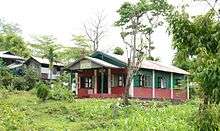Buxa Fort
Coordinates: 26°45′17.86″N 89°34′49.04″E / 26.7549611°N 89.5802889°E
| Buxa Fort | |
|---|---|
| Alipurduar district, West Bengal | |
|
West Bengal | |
 Buxa Fort | |
| Coordinates | 26°45′17.86″N 89°34′49.04″E / 26.7549611°N 89.5802889°E |
| Type | Hill Fort / Prison |
| Height | 867 metres (2,844 ft) |
| Site information | |
| Controlled by | British Raj |
| Open to the public | Yes |
| Condition | Ruins |
| Site history | |
| Built by | British Empire |
| In use | Abandoned in 1951 |
| Materials | Bamboo (original), Stone |
| Battles/wars | Bhutan War |
Buxa Fort is located at an altitude of 867 metres (2,844 ft) in the Buxa Tiger Reserve, Alipurduar district, West Bengal. It is located 30 kilometres (19 mi) from Alipurduar, the nearest town.[1] The Bhutan King used the fort to protect the portion of famous Silk Route connecting Tibet with India, via Bhutan. Still later during unrest in Occupation of Tibet, hundreds of refugees arrived at the place and used the then abandoned fort as refuge.
History

Its origin is uncertain. Before the occupation of the fort by the British, it was a point of contention between the King of Bhutan and the Cooch Kings.
British occupation
The British on invitation of the Cooch King intervened and captured the fort which was formally handed over to the British on November 11, 1865 as part of Treaty of Sinchula.[2] The British reconstructed the fort from its bamboo wood structure to stone structure. The fort was to later be used as a high security prison and detention camp in the 1930s;[3] it was the most notorious and unreachable prison in India after the Cellular Jail in Andaman. Nationalist revolutionaries belonging to the Anushilan Samiti and Yugantar group such as Krishnapada Chakraborty were imprisoned there in the 1930s. Forward Bloc leader and ex-Law Minister of West Bengal, Amar Prasad Chakraborty, was also imprisoned at Buxa Fort in 1943. Besides, some communist revolutionaries and intellectuals like the poet Subhash Mukhopadhyay were captivated here in the 1950s.
Tibetan refugee crisis
Drepung was one of the most celebrated monasteries in Tibet, and with over 10,000 monks before the Chinese invasion. But in March 1959, Chinese troops tasked with quelling the Tibetan uprising moved aggressively against the monastery; Only a few hundred monks escaped to India. These expatriate monks, representing all the diverse Tibetan orders, first set up a monastic study center and refugee camp in Buxa Fort, on the grounds of the jungle-bound former prison camp.[4]
In 1966, the Indian Ministry of External Affairs was alerted to the conditions of the Buxa refugee camps, and it became apparent that the Tibetan refugees would have to be relocated to a more hospitable place. Initially reluctant, a message from the Dalai Lama, urging them to think of the future and to strive for sufficiency, and the option of settling near other Tibetan refugees convinced the monks to move, and in 1971 the monks moved to their new locations at Bylakuppe and Mundgod in the state of Karnataka.[5]
Trekking

The following routers are popular among tourists and nature lovers –
- Santalabari to Buxa Fort 5 kilometres (3.1 mi)
- Buxa Fort to Rovers point 3 kilometres (1.9 mi)
- Santalabari to Roopang valley 14 kilometres (8.7 mi)
- Buxa Fort to Lepchakha 5 kilometres (3.1 mi)
- Buxa Fort to Chunabhati 4 kilometres (2.5 mi)
References
- ↑ "Buxa Fort - About". Retrieved 9 May 2012.
- ↑ Singh, Nagendra (1978). "Appendix VII – The Treaty of Sinchula". Bhutan: a Kingdom in the Himalayas : a study of the land, its people, and their government (2 ed.). Thomson Press Publication Division. p. 243. Retrieved 2011-08-25.
- ↑ "West Bengal Forest Development Corporation". Retrieved 9 May 2012.
- ↑ "About The Re-establishment of Drepung Gomang Monastic University in India". Drepung Gomang Monastery. Retrieved 2014-04-29.
- ↑ "Buxa Refugee Camp" (PDF). Retrieved 9 May 2012.
| Wikimedia Commons has media related to Buxa Fort. |